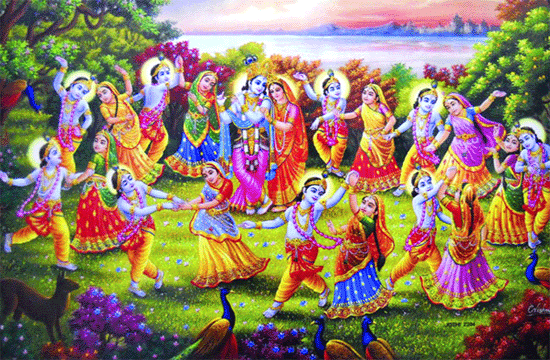Interpretative methodology explains lord Krishna’s amorous relations with the gopis and Radha, says ASHA GOSWAMI
There is much controversy over Krishna’s youthful love with the gopis. In order to answer the query as to why lord Krishna — who is purnakaama as he has fulfilled all his desires and is a complete incarnation of the Almighty — is portrayed in the Puranic sources in an amorous tinge. Moreover, his leelas such as those expressive of amorous relations with the gopis, like concealing their attire, raasleela with them, as well as his relation with Radha, are criticised adversely and may be viewed not on the terrestrial grounds, but on the basis of symbolism.
The symbolism working under the concept of love of gopis and Radha for the lord, and his enactment of the raasa in their company, need to be explored for knowing the hidden implications of Puranic texts.
Interpretative methodology, which offers as many interpretations of a chronicle as possible, comes to our help in solving an interiquate issue related to lord Krishna having amorous relations with the gopis and Radha. Besides, the religious history of India reveals that to counteract the influence of the heterodox religions among the tribes living in the regions around the middle and western India, Krishna was raised from the status of the hero god to the status of a tribal god or the god of the masses.
Under these circumstances, it also became mandatory for the Puranakaras to associate him with the emotional side of bhakti and portray him as endowed with the role of the perfect god head, who being second to none is portrayed as a lover as well as the beloved of his devotees. The latter, who were although the individual souls and hence were named gopis, were the representatives of the lord’s own exclusive form. According to the Vaishnava theology, gopis in their former life were the Nityasiddhas and the Devasvprupas who out of their free will assumed the form of the gopis to enjoy personal love-attachment which they had cherished towards the lord.
The gopis are also viewed as his powers who are always permeated by his blissful and spiritual essence. They are looked upon as representing different manifestations of the divine shakti of the lord. As many as 16,100 princesses, whom the lord is stated to have married besides having eight chief queens, are also held identical with the gopis as representing his eternal beloveds. Another school of thought also holds the gopis as identical with the individual souls who always crave for eternal happiness in the form of Krishna, who is the embodiment of supreme bliss and thus both represent the Upanishadic duo “Tat Tvam asi.” On similar pattern, the raasa dance of Krishna with the gopis is also to be viewed symbolically.
Primarily, the doctrine of the divine sport seems to have worked behind the concept of this leela of the lord. Hence, it has to be treated “as a complete revelation of lord’s sweet attributes and all of his divine potencies. He as God, and Radha as soul are both cited as the main participants enacting this leela in the company of other gopis who along with Radha represent the individual souls. To demonstrate God’s all pervasive love, Krishna is portrayed in this raasleela not only displaying ardent love for Radha but for all the gopis equally. Hence, it is evident that the gopi’s passionate dance in the company of Krishna is symbolic of the soul’s intense longing and willingness to accord utter priority to love God and leave behind everything, to even her surrender of honour.”
Hence, re-appraising the dance of the lord with the gopis, it may be maintained that it signifies a type of erotic mysticism involving the divine sport of the lord with his part and parcel, the individual souls, which can transform the powerful sex impulse into a passionate divine emotion known as the devotional love, endowed with which the devotees are termed as the gopis and the devotee endowed with the degree of super devotion, which is known as mahabhaavta is personified as Radha.
The writer is a noted Indologist and authority on Krishnaite studies


























